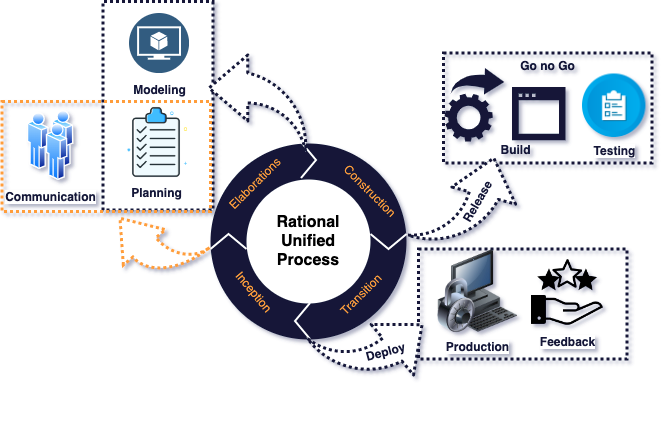Extreme programming (XP)
Extreme Programming (XP) is a software development methodology that emphasizes the importance of customer collaboration, simplicity, and frequent feedback in the software development process.
XP is a type of agile development methodology, which focuses on delivering working software quickly, through the use of short development cycles (usually called "sprints") and close collaboration between developers, customers, and other stakeholders.
XP involves a number of key practices, including:
Pair programming: Developers work in pairs, with one person writing the code and the other reviewing it in real-time. This helps to improve code quality and reduce errors.
Test-driven development: Developers write automated tests for the software before writing the code, to ensure that the code meets the customer's requirements.
Continuous integration: Developers integrate their code into a shared codebase frequently, to avoid conflicts and ensure that the software is always in a working state.
Refactoring: Developers regularly review and improve the design of the software, to make it simpler and easier to maintain
Overall, the goal of XP is to deliver high-quality software quickly, through collaboration, simplicity, and frequent feedback.
When To Choose Extreme Programming (XP)
It is particularly well-suited for projects with rapidly changing or highly complex requirements, as well as projects with a high degree of uncertainty or risk. Some common situations where XP might be a good choice include:
Projects with tight deadlines or where time to market is critical
Projects with a high degree of user involvement or collaboration
Projects with complex or rapidly changing requirements
Projects with a high level of uncertainty or risk
Projects that require a high degree of flexibility or adaptability
In general, XP is a good choice for any project where the ability to quickly and efficiently deliver high-quality software is a priority. It is particularly well-suited for projects where collaboration and flexibility are key, and where the ability to quickly respond to changes is critical.
Extreme Programming (XP) pros and cons
Pros:
XP emphasizes frequent and effective communication, which can help to ensure that all stakeholders are on the same page and that the project stays on track.
XP encourages collaboration and the active involvement of all team members, which can foster a sense of ownership and commitment to the project.
XP emphasizes simplicity and making only the necessary changes, which can help to reduce complexity and increase efficiency.
XP encourages the use of automated testing and continuous integration, which can help to identify and fix bugs early on in the development process.
Cons:
XP can be challenging to implement in a traditional organizational structure, as it requires a high level of collaboration and flexibility.
XP can be difficult to manage, as it involves frequent feedback and adjustments to the project plan.
XP can be time-consuming, as it emphasizes thorough planning and the continuous refinement of the project plan.
XP can be expensive, as it requires a high level of investment in automated testing and other supporting tools and technologies.
While Extreme Programming (XP) offers many benefits, like any methodology, it also carries certain operational risks that teams should be aware of. Some operational risks related to XP include:
Dependency on Customer Availability: XP relies heavily on customer involvement and feedback. If customers are not readily available or lack clarity in their requirements, it can lead to delays, misunderstandings, and rework.
Resource Intensive Practices: Some XP practices, such as pair programming and continuous integration, require additional resources and may be perceived as less efficient in the short term. This can impact project budgets and resource allocation.
Scope Creep: XP's flexibility in responding to changing requirements may result in scope creep if not managed effectively. Without proper controls, the project may expand beyond its original scope, leading to schedule delays and increased costs.
Team Dynamics: XP emphasizes close collaboration and shared responsibility among team members. While this can foster a strong sense of teamwork, it can also lead to interpersonal conflicts, particularly if team members have different work styles or personalities.
Documentation: XP prioritizes working software over comprehensive documentation. While this can improve agility, it may also lead to challenges in maintaining documentation for future reference or onboarding new team members.
Risk of Technical Debt: In the pursuit of delivering working software quickly, teams may take shortcuts or compromise on code quality. This can result in the accumulation of technical debt, which may slow down future development efforts and increase maintenance costs.
Lack of Predictability: XP's focus on responding to changing requirements may make it challenging to predict project timelines and outcomes accurately. This uncertainty can be particularly problematic in environments with fixed deadlines or budgets.
Dependency on Skilled Practitioners: XP practices such as test-driven development and pair programming require a certain level of skill and experience to implement effectively. If team members lack the necessary expertise, it can impact the quality and success of the project.
People Also Viewed










